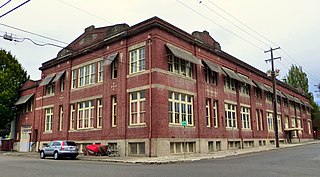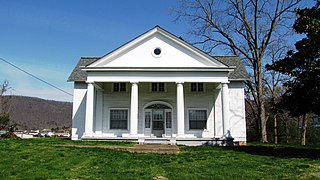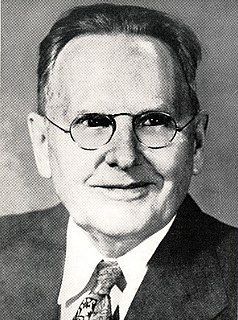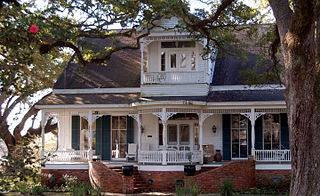
Maryville College is a private liberal arts college in Maryville, Tennessee. It was founded in 1819 by Presbyterian minister Isaac L. Anderson for the purpose of furthering education and enlightenment into the West. The college is one of the 50 oldest colleges in the United States and the 12th-oldest institution in the South. It is associated with the Presbyterian Church (USA) and enrolls about 1,100 students. Maryville College's nickname is the Fighting Scots. The sports teams compete in NCAA Division III athletics in the USA South Athletic Conference.

Alexander Jackson Davis, or A. J. Davis, was an American architect, known particularly for his association with the Gothic Revival style.
Minard Lafever (1798–1854) was an American architect of churches and houses in the United States in the early nineteenth century.

Natchez On-Top-of-the-Hill Historic District is a historic district in Natchez, Mississippi that was listed on the National Register of Historic Places in 1979.

The Drake Park Neighborhood Historic District is located adjacent to Drake Park near the historic downtown area in Bend, Oregon, United States. Because of the unique and varied architecture in the Drake Park neighborhood and its close association with the early development of the city of Bend, the area was listed on the National Register of Historic Places in 2005.

James Keys Wilson was a prominent architect in Cincinnati, Ohio. He studied with Charles A. Mountain in Philadelphia and then Martin E. Thompson and James Renwick in New York, interning at Renwick's firm. Wilson worked with William Walter at the Walter and Wilson firm, before establishing his own practice in Cincinnati. He became the most noted architect in the city. His Old Main Building for Bethany College and Plum Street Temple buildings are National Historic Landmarks. His work includes many Gothic Revival architecture buildings, while the synagogue is considered Moorish Revival and Byzantine Architecture.

The Bedford Village Historic District is a national historic district in Bedford, Westchester County, New York. The district contains 80 contributing buildings and one contributing site. It encompasses most of the original 1680 hamlet and is laid out in a typical village green plan. Notable buildings include the court house (1787), library (1807), school house (1829), post office, and Presbyterian church (1872). The buildings are good examples of the Greek Revival and Gothic Revival styles. Two of the buildings are now museums.

The Troy Laundry building, located at 1025 South East Pine in Portland, Oregon is a mixture of colonial, Egyptian and Renaissance revival architecture. With its large windows, tall brick walls, and decorative brick work, it is a site to behold, and knowing that it was build in 1913 makes it even more spectacular. It was built by Portland Native Architect Ellis Lawrence.
The Spanish Revival Residences in Mobile Multiple Property Submission is a multiple property submission of buildings that were listed together on the National Register of Historic Places as some of the best remaining examples in Mobile, Alabama of houses built in the Spanish Colonial Revival style. It covers ten properties.

The James Alexander Veasey House, also known as the Veasey-Leach House, is a Colonial Revival style house in Tulsa, Oklahoma that was built in 1913. It was listed on the National Register of Historic Places in 1989 "for its architectural significance as a local landmark example of the Colonial Revival style.".

John Thomas Blair (1885–1976), most commonly known as John T. Blair, was an architect and builder in Tulsa, Oklahoma. He was the 4th licensed architect in Oklahoma.

The architecture of Jacksonville is a combination of historic and modern styles reflecting the city's early position as a regional center of business. According to the National Trust for Historic Preservation, there are more buildings built before 1967 in Jacksonville than any other city in Florida, but it is also important to note that few structures in the city center predate the Great Fire of 1901. Numerous buildings in the city have held state height records, dating as far back as 1902, and last holding a record in 1981.

Morningside is a historic house in Maryville, Tennessee, U.S.. It was built in 1932 for Mrs John Walker, whose sister was married to Dr. W. P. Stevenson, the chaplain of Maryville College. It was designed in the Classical Revival architectural style. Mrs Walker willed it to Maryville College when she died in 1950, and it was used as the college president's house. Later, the college sold it to Dr. Lloyd Langston, but they bought it back when he died. It has been listed on the National Register of Historic Places since July 25, 1989.
The Dement House, also known as Colonial Acres, is a historic house in Lascassas, Tennessee, U.S.. It was first built as a log cabin by Abner Dement, the son of a French immigrant and slaveholder, in 1817. When Abner was murdered by one of his slaves in 1825, the cabin was inherited by his son John, who lived here with his wife Christine Overall. The couple hired Arch Hite to turn the cabin into a two-story house with a portico designed in the Greek Revival architectural style in 1833. The house has been listed on the National Register of Historic Places since June 25, 1986.

The A. E. Perkins House is a historic house in Jacksboro, Tennessee, U.S.. The house was built circa 1850 for James Williams and his wife, Rebecca. It remained in the Williams family until 1930, when it was purchased by Alexander Early Perkins.

George Awsumb was a prominent Norwegian-American architect in the first half of the 20th Century. Awsumb defined architecture as “frozen music” designed for the “man on the street.” He was influenced by his early life, European travels, and prevailing architectural trends of his time. His eclectic, progressive portfolio included neoclassical, Gothic Revival, Prairie School, and International Style designs. Several buildings that Awsumb designed have been in continuous use in the American Midwest and South for over 100 years. In particular, Awsumb began a family architectural legacy that contributed to the progress and development of Memphis, Tennessee.

The Mollie and Neel Glenn House is a historic house in Springfield, Tennessee, U.S..
The John Rushing Farm is a historic farm with a main house and several buildings in Camden, Tennessee, U.S..

Argyle is a historic house on a former sugarcane plantation in Houma, Louisiana. It was built circa 1906 for Phelin Bonvillain, a sugar planter. It belongs to the Ingram family since 1947.

The Stewart-Anderson House is a historic mansion in Tupelo, Mississippi. It was built in 1867. It served as the Tupelo Female Academy and it later became the private residence of state representative and senator W. D. Anderson, who also served as the mayor of Tupelo from 1899 to 1907.

















